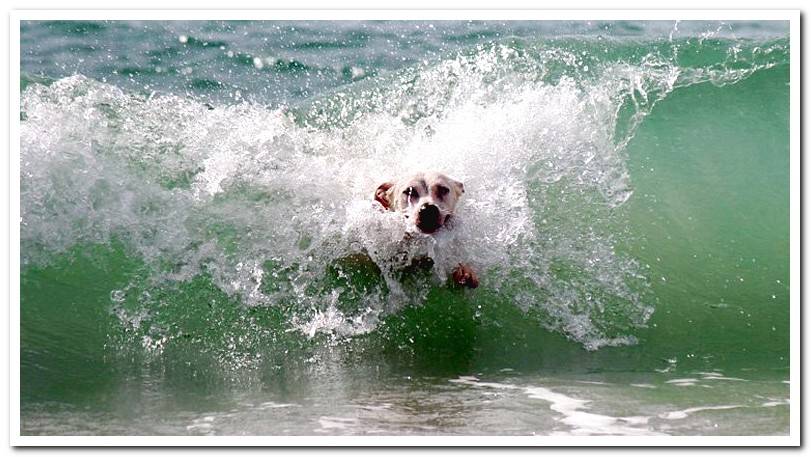
With the summer heat, there are many of us who want to spend the day at the seashore enjoying a good day at the beach. Many dogs also know how to enjoy this natural environment and, in fact, they have a great time.
But can dogs go to the beach? In this Dogsis article we explain what are the benefits, dangers, tips and legality of this practice so you can plan a refreshing trip for you and your best friend.
- You may also like: Can a dog burn its paws?
Index of contents
- 1 Benefits of going to the beach with dogs
- 2 Dangers of going to the beach with a dog
- 3 Tips for going to the beach with a dog
- 4 Is it legal for my dog to go to the beach?

Benefits of going to the beach with dogs
The beach is a perfect place for dogs to enjoy walking or running on the sand and taking a dip in the water. But is that, in addition to the fun it offers, going to the beach with your furry friend has all the benefits listed below.
- The beach helps you both fight the stifling heat of some summer days together.
- Running on the sand or swimming is a very healthy exercise that helps the dog stay in shape.
- The sun provides vitamin D, essential for the well-being and health of the dog.
- Salty water cleanses mucous membranes of harmful bacteria and helps to disinfect and heal wounds and skin conditions thanks to its healing and antiseptic properties and to prevent infections thanks to its antibacterial and antimicrobial properties.
- Sea water is also good for relieving itching caused by diseases such as atopic dermatitis, seborrheic dermatitis, dandruff, psoriasis, or scabies.
- Beach fun increases your happiness levels and lowers stress levels.
- This outdoor activity helps reinforce the dog-human relationship and allows you to teach your four-legged friend basic commands, such as “come” or “wait” in a different environment.

Dangers of going to the beach with a dog
However, the beach also has some aspects that could jeopardize the safety of your pet. Therefore, now we will talk about all those dangers and how important it is to watch your dog so as not to turn a beautiful day at the beach into a nightmare.
First, although dogs who venture out into the water usually know how to swim, the tides can tire them out a lot and become a huge danger, even to expert swimmers. Do not take your eyes off your dog at any time.
Be especially careful with heat strokes! Elderly dogs and puppies, as well as others with conditioning factors such as obesity or heart problems, are the most likely to suffer a heatstroke, although anyone can suffer it.
The skin burns They are another of the most frequent problems that dogs suffer during a day at the beach. Dogs with short, white fur and light or pink fur, such as Dalmatians, are especially prone to sunburn.
Many dogs drink seawater out of thirst or as a game. However, this water is very harmful to your body, as it causes hypernatremia, very high levels of salt in the body, which causes significant gastrointestinal poisoning.
Biting or swallowing sand is also dangerous and can cause dysentery in dogs, like salt water.
Also, in the sea we can find almost everything … from marine animals such as hedgehogs and jellyfish to trash, hooks or other sharp things that can cause injuries or hives in our pets.
- You will be interested to know: What happens if my dog drinks sea water?

Tips for going to the beach with a dog
To avoid all these problems mentioned above, we recommend you follow these 10 tips:
- Before leaving, do not forget to take your dog’s papers, sunscreen, water, a drinker, an umbrella, bags to collect his needs and a toy for your friend.
- Respect the instructions and avoid bathing with your dog when there are strong currents.
- Be vigilant and watch your dog at all times when he gets into the water.
- Bathe with it in areas where it does not cover excessively. It is important that the dog knows how to follow some basic orders to get out of the water if you see any danger, such as a jellyfish.
- Avoid going to the beach during the hottest hours (11:00 a.m. – 16:00 p.m.)
- Provide plenty of fresh water and shade for your puppy.
- Apply sun protection to your dog in sensitive areas, especially in parts with little pigmentation or hair, such as nose, ears and pads. Repeat this often, especially if you get into the water.
- Completely prevents the dog from drinking sea water. Offer her fresh water constantly to keep her from thirsting and falling into temptation.
- In case of suffering an incident from a sharp or poisonous object or animal, we should remove the object or thorn in question if possible and apply an antiseptic cream. If, on the other hand, it causes a reaction on your skin, such as hives, or we cannot remove the object, we must go to the vet as soon as possible.
- Rinse your friend after the beach day with plenty of fresh water to clean the salt, sand and other minerals that can harm their skin and coat.

Is it legal for my dog to go to the beach?
Although in recent years the number of beaches where dogs are accepted has increased, it is vitally important that owners inform themselves before accessing the bathing area of whether dogs are allowed.
The regulations for the access of dogs on beaches are varied and depend on the town hall of each locality and the season. However, visiting a coast that does not allow dogs can cost you a fine of between € 90 and € 3,000.
There are many coastal areas not restricted by these laws where dog bathing is allowed. If you want to know which beaches allow dogs in our country to spend a quiet day without unpleasant surprises, visit: Dog friendly beaches in Spain.
